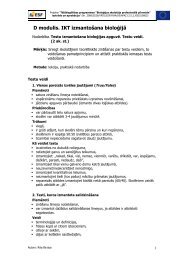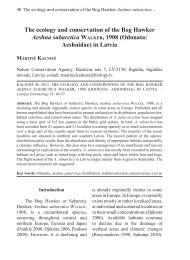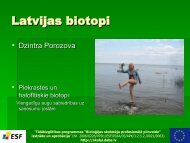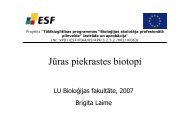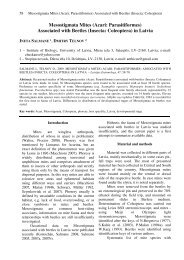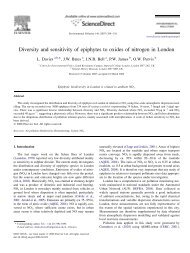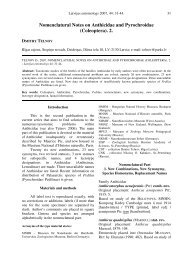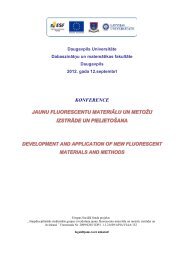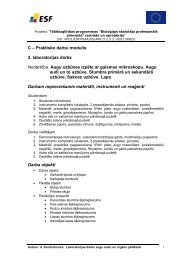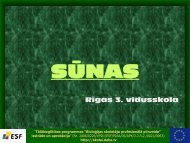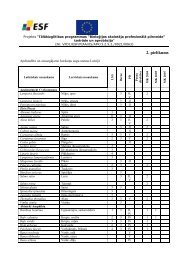Odonata - Entomological Society of Latvia - Latvijas Daba
Odonata - Entomological Society of Latvia - Latvijas Daba
Odonata - Entomological Society of Latvia - Latvijas Daba
Create successful ePaper yourself
Turn your PDF publications into a flip-book with our unique Google optimized e-Paper software.
3.3. THE OCCURENCE AND POPULATION DENSITY OF GOMPHIDAE LARVAE IN RIVER GAUJA<br />
Distribution. Three species <strong>of</strong> gomphid larvae were found in the River Gauja – Gomphus<br />
vulgatissimus, Onychogomphus forcipatus and Ophiogomphus cecilia. Gomphidae were present in<br />
21 squares. G. vulgatissimus was recorded in 20 squares, O. forcipatus – in eight squares and<br />
O. cecilia larvaes in 5 squares. Gomphus flavipes was not found in this study.<br />
Occurrence. Overall, gomphid larvae were found in 37 quantitative samples from 18 sites <strong>of</strong><br />
river Gauja. Larvaes <strong>of</strong> G. vulgatissimus mostly were found in samples, less – O. forcipatus<br />
(Table 5).<br />
Table 5. Number and occurrence <strong>of</strong> gomphid larvae in quantitative samples <strong>of</strong> macrozoobenthos<br />
collected in the River Gauja from Taurene upstream to Carnikava downstream in 1998.<br />
Species<br />
Total number <strong>of</strong><br />
samples with<br />
Gomphidae<br />
Total number <strong>of</strong><br />
specimens<br />
% from all<br />
(n=280) samples<br />
% from samples<br />
with Gomphidae<br />
(n=37)<br />
Gomphus vulgatissimus 28 34 10.0 75.6<br />
Onychogomphus forcipatus 14 19 5.0 37.8<br />
Ophiogomphus cecilia 2 2 0.7 5.4<br />
Seven substrate components from samples were selected: sand, gravel, pebbles, cobbles,<br />
mud, detritus and macrophytes. In 11 % <strong>of</strong> the samples the substrate was uniform, in 49 % there<br />
were two components, in 32 % – three components, and in 8 % – four components. Sand, gravel<br />
and mud occurred most frequently and was found in all samples. In Gomphidae samples the best<br />
represented component was cobbles also (Figure 9). In the analysis <strong>of</strong> the distribution <strong>of</strong> the sample<br />
substrate components for G. vulgatissimus and O. forcipatus it was found that for G. vulgatissimus<br />
the larvae mainly inhabit sandy and muddy micro habitats, while O. forcipatus prefers micro<br />
habitats with gravel and pebbles (Figure 10).<br />
Pe<br />
4%<br />
Gr<br />
24%<br />
Co<br />
10%<br />
Ma<br />
5%<br />
all samples (n=280)<br />
Mu<br />
19%<br />
Sa<br />
36%<br />
De<br />
2%<br />
Pe<br />
7%<br />
Co<br />
17%<br />
Gr<br />
20%<br />
Ma<br />
4%<br />
Mu<br />
20%<br />
De<br />
1%<br />
Sa<br />
31%<br />
samples with Gomphidae (n=37)<br />
Figure 9. Division <strong>of</strong> substratum by components represented in the samples (Sa – sand; Gr – gravel;<br />
Pe – pebbles; Co – cobbles; Mu – mud; De – detritus; Ma – macrophytes) in the River Gauja from<br />
Taurene upstream to Carnikava downstream in 1998.<br />
60



